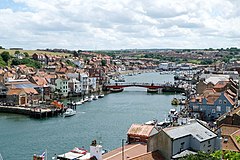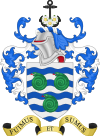
Back Strēanæshealh ANG ويتبي Arabic مدينة ويتبى ARZ ویتبی AZB Whitby (Yorkshire) Breton Whitby Catalan Whitby (lungsod sa Hiniusang Gingharian, Inglatera, North Yorkshire, lat 54,49, long -0,61) CEB Whitby Welsh Whitby Danish Whitby German
| Whitby | |
|---|---|
| Town | |
 View of Whitby from the West Cliff | |
 | |
Location within North Yorkshire | |
| Population | 13,213 (2011 census)[1] |
| OS grid reference | NZ893109 |
| Civil parish |
|
| Unitary authority | |
| Ceremonial county | |
| Region | |
| Country | England |
| Sovereign state | United Kingdom |
| Post town | WHITBY |
| Postcode district | YO21, YO22 |
| Dialling code | 01947 |
| Police | North Yorkshire |
| Fire | North Yorkshire |
| Ambulance | Yorkshire |
| UK Parliament | |
Whitby is a seaside town, port and civil parish in North Yorkshire, England. It is on the Yorkshire Coast at the mouth of the River Esk and has a maritime, mineral and tourist economy.
From the Middle Ages, Whitby had significant herring and whaling fleets,[2][3] and was where Captain Cook learned seamanship. He first explored the southern ocean in HMS Endeavour, built there.[4]
Alum was mined locally, and Whitby jet jewellery was fashionable during the 19th century.[citation needed]
Tourism started in Whitby during the Georgian period and developed with the arrival of the railway in 1839. The abbey ruin at the top of the East Cliff is the town's oldest and most prominent landmark. Other significant features include the swing bridge, which crosses the River Esk and the harbour sheltered by grade II listed east and west piers. There are statues of Captain Cook and William Scoresby, and a whalebone arch on the West Cliff. Whitby featured in literary works including Bram Stoker's novel Dracula.
Whitby is 47 miles (76 km) from York and 22 miles (35 km) from Middlesbrough.
- ^ Cite error: The named reference
2011 censuswas invoked but never defined (see the help page). - ^ "BLESSING THE HERRING FLEET – British Pathe". britishpathe.com. 2011. Archived from the original on 29 July 2012. Retrieved 20 October 2011.
- ^ "Whaling in Whitby – Whitby Online". whitbyonline.co.uk. 2011. Archived from the original on 6 March 2016. Retrieved 20 October 2011.
- ^ Hough 1994, p. 55
